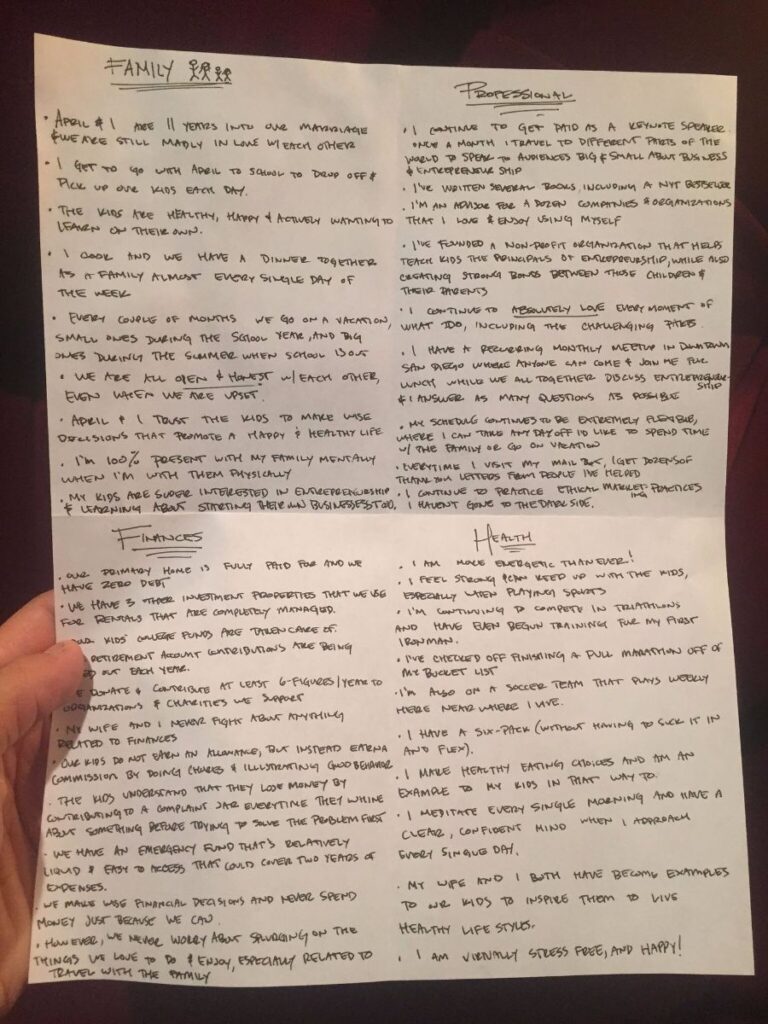It’s None of My Business

Have you heard of that thought-provoking question people often ask in a “get-to-know” group setting? “What would you do with your life if money wasn’t an issue?” It’s a fair question. It will definitely help you look deep within and even examine your current life status and purpose. This can often lead to asking yourself another question… “Why am I doing what I am doing?”
But, I have a better thought-provoking question for you. But first, a story.
I immigrated to the US when I was 10 years old with my mom, my dad, and my older sister. We were a happy family of 4. My dad is a dreamer and wanted something better for himself and for us. I remember vividly the excitement of this new life. I am also a dreamer, and I’ve always dreamt of experiencing America to the fullest—the richness, the endless opportunities, the gigantic malls, the beautifully developed communities… oh, and Disneyland. I couldn’t wait to go there.
Turns out, the transition to the whole new, unknown world isn’t as easy as it seems. And the dreams that were so visible weren’t as reachable as shown in the movies. In fact, looking back, that very transition became one of the toughest and most painful journeys I’ve experienced in my life. Not only as a kid experiencing rejection and being bullied for the first time at school, but lots were happening at home. There’s an unbearable amount of pressure and burden from my parents. Whether spoken or unspoken… or even sometimes screamed in my face, I soon realized that I carried the hope and the fulfillment of their “dreams” which rested on my tiny little shoulders. Was that even fair?
Looking back, these traumatic years re-shaped my core as a person. I learned to live my life on other people’s terms. They determined my identity. They determined my purpose. They determined my happiness. They determined how I should live my life. I didn’t want that to happen… it just did. What “they” thought of me mattered. It mattered so much.
I heard this quote about 10 years ago that made me think, and it goes like this…
“At 20, you care what everyone is thinking about you. At 40, you don’t give a damn what people are thinking about you. At 60, you realize no one is thinking about you.”
It’s kinda funny, isn’t it? I think there’s some truth to it. In fact, I think I am in the 2nd stage of life where I am learning to care less about what others think about me, and let me tell you, it’s been very freeing. Along the same thought, I heard this quote which I think is so profound and even more freeing in a way.
“What others think about you is none of your business.”
Whoa!!
Don’t get me wrong. This is not a license to be a complete jerk because you don’t care what others think about you anymore, but it’s a way to look deep within and be true to yourself and to rediscover yourself and to be confident in who you are.
So, here’s my second thought-provoking question that you’ve been waiting for. “What would you do with your life if you didn’t care what others thought about you?” If that’s hard to answer, let’s phrase it like this. “What would you do with your life if no matter what you did, others will think the best of you.”
We have work to do. We have our dreams to dream, goals to reach, people to love, purpose to fulfill, lives to live. We don’t have time to waste any of our precious energy being bullied by the naysayers or those critics of you. Because, you know what? What they think of me is none of my business. Carry on.
Don’t Give Up, Find the Way!

As I approach an age where I inquire about a separate senior citizen menu at restaurants, I’m searching for heroes in my own age group. What’s the point of having audacious goals if they’re simply physically impossible? For instance, most PGA professionals on tour and the young whipper-snapper high school/college golfers are hitting the ball past 300 yards with swing speeds of 120+ mph. Meanwhile, mine is in the 90s, and I can only manage to drive 230 yards at most. My dream of hitting the ball past 300 yards is long gone. Poof! Gone. It’s never going to happen. It’s physically impossible.
Or is it?
If you’ve been following my series on “Inspiration,” do I have a story for you! In fact, I’ve shared this story many times, and I revisit this video every year. Also, the documentary just came out, and I’ve finished watching it. Something about it pumps me up and makes me say out loud, “I am going to find a way!”
Diana Nyad is an American long-distance swimmer. She gained international fame for her extraordinary achievements in open-water swimming. One of her most notable accomplishments came in 2013 when, at the age of 64 (yes, you heard that right), she became the first human to swim from Cuba to Florida without the aid of a shark cage. To this day, no one else has accomplished this feat.
Her journey to achieve this extraordinary feat was marked by determination and perseverance—no kidding. She attempted the swim multiple times throughout her career, facing challenges such as dangerous sea conditions, jellyfish stings, and extreme exhaustion.
Despite setbacks, she remained committed to her goal and finally succeeded by swimming approximately a 110-mile stretch in about 53 hours. Yes, you heard that right—53 straight hours of swimming in the open sea. Pure determination, pure will, and pure courage!
Her achievement at an age when many consider retiring and ordering from a discounted menu has made her an inspirational figure, showcasing the power of resilience and the human spirit. Diana Nyad’s life story is not only one of athletic triumph but also a testament to the idea that age should not be a barrier to pursuing one’s dreams.
She’s also an incredible communicator and speaker. She has now written a book and continues to inspire many through her words of wisdom. Here are some of my favorite quotes that she lives her life by:
“When you achieve your dreams, it’s not so much about what you get; it’s about who you’ve become in achieving them.” Diana emphasizes the value of the journey, independent of the ultimate outcome. The pursuit of a dream is meaningful in its own right, regardless of whether the final destination is reached. For her, it was extra sweet for reaching the ultimate outcome.
This quote particularly speaks to me: “You can chase your dreams at any age – you are never too old!” Amen to that.
And how about this last quote: “Never, ever give up. Find a way.” This resonates beyond the realm of sports and swimming. It’s a reminder that in the pursuit of anything, there will be hurdles. But the key is to remain resilient, resourceful, and persistent. We have to focus, be creative, and be determined until we find a way.
Let’s find a way.
Here’s a TED Talk she did after her incredible feat that I watch every year. I hope you take the time to watch, listen and be inspired.
What I Learned From a Quote From an Avalanche Survivor

I grew up in Reno. When you want to travel to Lake Tahoe to witness the breathtaking views of the lake surrounded by snowcapped mountains during the summer or just simply want to take on the black diamond ski slopes during the winter, you fly into Reno. Tahoe is just hop-skip away to the wonders of Lake Tahoe and Reno is the closest city to have an international airport. In fact, as a kid growing up, we consider the ski slopes of Tahoe our own backyard. There’s a Junior Ski program that takes a bus full of kids every Saturday 30 minutes to the closest ski resort to get them started mastering the slopes early in their childhood. Our high school had a downhill ski team that competed against other schools in the county and some went on to become a professional skiers. All that to say, ski culture in Reno is second to none.
So, when I saw the trailer for this Feature Length Documentary called BURIED, based on the 1982 avalanche in Alpine Meadows (ski resort at Tahoe know for incredible summit-to-base groomed grails and panoramic views of Lake Tahoe and the peaks of the Sierra Nevada), I was intrigued and just had to watch it. Here it is…
In 1982, a massive avalanche had crashed into the base area of the ski resort after a four-day storm which had dumped close to eight feet of snow along with 100 mile per hour winds. The resort was closed but a few employees remained at the headquarters. And at 3:45 pm a tidal wave of snow came down and destroyed the building and buried the parking lot killing seven innocent lives. Here’s a crazy part of this story (warning: spoiler alert), one woman named Anna Conrad was found alive after being buried in the snow for a total of five days. She was located by a trained search dog, a German Shepard named Bridget. It took total of 117 hours for her to be found. It was a miracle beyond miracle that she was alive. She had been trapped in the second floor of a three-story ski lift building. She crawled into a space between all debris and a bench, surviving on melted snow.
When asked later while she was waiting to be rescued for 5 days if she ever gave up hope. “No.” She said. “I knew they would come” She never lost hope.
After this traumatic experience, the recovery back to the norm obviously wasn’t easy for her. She was dealing with the loss of her friends and the loss of the love of her life. At the same time, she was also trying to overcome survivor’s guilt of asking why. On top of that, the tough news she was told was that she would have to have her right leg amputated.
As devastating as that new way, this is how she responded. “What happened to me was a fantastic miracle, I can’t believe that I made it. It’s like so many miracles occurred all at once to save me, it’s just…it’s overwhelming. Learning about my leg amputation was very hard at first, but I decided there was no use being depressed, I was going to have to live with it so I might as well accept it.”
In the spirit of our new series “Inspiration”, I wanted to share this incredible survival story of Anna with you. I walked away from this documentary being reminded once again the fragility of life. And beyond that, I was inspired by her never giving up hope through one of the most hopeless circumstances. But most of all, I am inspired by her attitude of gratefulness and putting it all into perspective in the midst of her own painful journey. Her courage to accept, her courage to hope and her courage to live is inspiring. Are you inspired? My question now is how will this change and impact me? How will I learn to accept the things that doesn’t show up in my favor and how will I continue to see the hope and be grateful no matter what the circumstance I am facing? I would love to hear your thoughts.
Quotes that Changed Everything

The Flight Simulator

In my past life, I was a design engineer. I designed products on a sophisticated 3D modeling software and put it through another program that flattens the design with all the sheet metal bend lines calculated (the metal stretches when you bend it, so you have to factor that in). When that’s complete, we put it through a CNC machine where it cuts, punches and embosses. When that’s done, it goes through a series of processes (deburring, bending, welding, etc) until it becomes a part.
Most products we designed had 10-30 parts, not including all the other components that make it work. And, for each production run, we made 100-5000 parts at a time. So, now imagine if one of the parts that was designed had a calculation error and during the final assembly, it doesn’t fit in place. OMG!! Trust me, I’d be the first one to get notified, and when I run out there to verify whose fault it was, everyone is on edge. If the parts are faulty, it has to be scrapped and the labor hours and material cost that was lost gets charged to the department that messed up. Talk about stress.
But us smarty-pants in the engineering department came up with an idea to reduce scrap cost being charged to our department. We built a model shop next to our office and had two incredibly talented builders that simulated everything that would happen in the production. They built every part that we designed one by one and assembled it at the end to ensure everything would fit and function. Brilliant? Yes! Stressful? Not any more.
For our finale of “Will It Fly” (a series dedicated to helping you to test the viability of any business ideas you might have), let’s quickly go over what it means to create a simulator for our business so that we can avoid unnecessary mistakes and costs and help you validate the idea on a small scale so that you can make sure it will work.
Ready? Here we go.
First, let’s be perfectly clear, validation is not someone telling you they would buy, like, read, consume, watch or listen to something you create. Validation is based on certain actions they take. Follow this formula for validation.
Step 1: Get in front of an audience
You have to have access to an audience of people in your market. If you already have it, great! If not, you have to build it yourself. There are many ways to do this. For instance, you can do targeted advertising through Google ads and social media marketing. You can guest post, hang out in forums offering answers, create engagement on groups, crowdfunding platforms…all these examples are listed in the book Will it Fly by Pat Flynn and also in the free companion course.
Step 2: Interact and share your solution
After you’ve discovered who your prospects are, it’s time to interact with those people directly. You’re not quite presenting your solution yet, but you’re really close. The idea here is to start to engage with the people who have signaled interest. All selling starts with the relationship, which means that you have to make sure that you begin by getting the person on the other end to know, like, and trust you. Qualify yourself, be honest about what you’re up to, offer the pitch…don’t ask for payment, just sell the idea for now.
Step 3: Ask for the transaction
Asking for a payment before you build your product might feel weird, but again, if you are honest about this with your prospect, it won’t be an issue. In fact, it’s pretty common to do this…just look at the Kickstarter platform – it gets funded first before it gets built. It’s a common practice. This might be the hardest step in your simulation process, but it’s well worth it. Will people that you engage with that believe in your idea put their wallet where their mouth is? This will be a sure sign that they not only believe it, they are willing to bet on it.
I love how the image above gives you a pilot’s point of view. If you’ve reached this point, “Will it Fly?” is no longer a theoretical question – it’s an opportunity to see your business defy gravity and take off! In the words of the poem High Flight, you’re ready to “slip the surly bonds of Earth and dance the skies.”
I’m so happy to have been your wingman in this process! Here’s a little music to inspire you as you go.
See you around the wild blue yonder!
It’s Not About You

I love that you are still following through with this awesome series called “Will it Fly?” I hope it’s providing the tools you need to navigate the marketplace as you prepare to launch your idea into the world.
Last week, I helped you measure the climate of the market, discover your target audience, find who the top influencers are and even what products are currently being offered in the space.
Hopefully by now, your idea has taken new shape through all the exercises and “homework” we’ve completed. You are doing awesome!
The kicker is this. The most important thing to realize for your business to succeed is: the business is not about you at all. I’m sorry – I know you’re doing so much work, but ultimately it’s all about serving your target customer.
So, let’s dig deeper into understanding your target customer. Let’s get into the mind and emotion of your end-user so that you know exactly what they’re going through and how you can best provide a solution. Let’s call it Your Customer P.L.A.N. which is broken down into four sections:
Problem – Language – Anecdotes – Needs
Problem: A business idea is really just a potential solution to target and solve your customer’s pain or a problem. The better, simpler and faster you can solve it, the more successful your business will become. How do you find out what those pain points are? By asking the right questions. Here they are:
- What’s something about [topic] that frustrates you?
- If you had a magic wand and could change anything related to [topic] what would it be?
- What problems are costing you the most money right now?
- What’s the most important activity related to [topic] that you do?
- What related to [topic] takes up the most time?
- Do you use anything to help you with [topic] already? What do you like about it? What do you wish was better?
- What’s something related to [topic] that you have to keep doing over and over again?
Language: When I see a little baby staring back at me, I do a high-pitched baby talk to communicate on the same level…using lots of face expressions and such. It’s hilarious if you think about it, but very effective. When you start a business, one of the most important things you can do is understand the language your target customer uses to communicate. What words do they use to share their pains and struggles? How do they describe their dreams and goals? Speaking the same language can help make a connection and build trust.
Anecdotes: An anecdote is a short, interesting story, and they’re some of the most powerful tools you can use in your business…especially when you are marketing and promoting your products. Framing it all within a story can have a massive impact on how well others relate and respond. It reminds me of a guy who was about to go bankrupt, but then one day he found an anecdote and everything changed… his name? Abraham Lincoln. (see – it totally works!)
Needs: In this final part of the P.L.A.N., with all the research you’ve done in mind, create a list of needs that your target customers have. Now remember, there are different levels of need. If your idea is to create and sell healthy smoothies, you could be meeting multiple levels of need, such as:
- Need for space for hip, young teens to gather
- Need for meal substitute for weight loss
- Need for healthier lifestyle
- Need for nice cold thirst quencher on a hot day
Instead of just choosing a product or business to build at random, now you’ve got something with good research to back it up, increasing the likelihood that you are building something that actually matters. And that’s the PLAN.
Hopefully, your original idea has morphed into something unique by now, and you have more clarity on the direction to take it.
Again, don’t forget to check out the book Will it Fly by Pat Flynn and sign up for your very own companion course for free which I am using for this series. It goes into a lot more detail which will help you even more.
You know what they say: if you fail to plan, you plan to fail. But in light of Will it Fly, I’m taking it even further: if you fail to plan your PLAN, you’re a failing plane crashing toward your own planned failure.
In other words, Don’t be a Failed Plantain; be a Banana with a Plan-a.
Why And How Should I Create A Market Map?

If you are just tuning in, we’ve been talking all about “Will it Fly?” It’s a series dedicated to helping you do the research for any business ideas you might have to test their viability.
This week, I am going to share some strategies on Market Mapping. It’s basically a way to gather information on what’s already out there and working. The more you know that, the more you can stand out from the crowd. The last thing you want to do is create something that just blends in with the rest – we want to get you noticed.
With this Market Map, you’ll get a bird’s-eye perspective of the surroundings you’ll be entering to help you navigate through it all with knowledge and confidence. This Map will also become a useful guide to refer to as you are developing and growing your idea into a full business.
So, our research will begin with the 3 P’s.
- Places
- People
- Products
Start a new spreadsheet and label the columns “Name” “Web Address” and “Notes.” Let’s get to work.
Places: No matter what business you are looking to start, you’ll need to find out where your future customers hang out online. Not only do you get to search all the websites that are out there dedicated to your idea, but you’ll get to learn more about who they are.
- Start googling all the keywords surrounding your idea and look up 15+ websites. Enter them in your spreadsheet: the name of the company, the website address and the brief description of what they do and who they serve.
- After that, search all the blogs that are written out there. For example, a simple way to do a Google search on blogs dedicated to fly fishing would be to enter “blog: fly fishing” in the Google search box.
- Search the forums that are dedicated to your search. This is where people ask questions, discuss their pain points and offer solutions. Again, you can just enter “forum: fly fishing” in the Google search box.
- Look for all the social media groups. Join them and look around. These are your people. Engage and learn. Make friends.
People: Now that you know where they are, it’s also important to know who they are and who is already serving them. Find the top dogs in the space, learn how they interact and engage with their audience.
- Find the influencers on social media. What are they saying? What are they solving? What are they discussing? What are they sharing? Find the accounts with the largest number of followers – what makes them special? Why are they being followed by so many?
- Search relevant podcasts. They have incredible resources and you can get a transparent look at what they are sharing. Look at the top ranked and rated podcasts related to your niche and find who has been interviewed on shows related to that space.
Products: Find the top products, services and books that are being offered to your audience. In other words, what are people willing to spend their money on right now?
- Amazon is a great place to start. It’s not only a place to find products but it’s also a sophisticated search engine. You can type in a keyword and it will spit out all the products that are sold in that category. Pay attention to specific products and the price.
- Also note the books that pop up in your search on Amazon. Keep track of the authors, since they will also be influencers in that niche.
- Read through the product reviews and solutions to problems.
You should have a pretty good idea by now what’s out there and who’s who in your niche. You should also have a better sense of what’s missing that you can provide that will help you stand out in the crowd. Remember, solve their problem and do it in a unique way. This is your formula for success.
Is this helping you? Is your idea getting more and more solidified through these exercises? I hope so.
We have a few more things to go over until we are ready to launch. Don’t forget to check out the book Will it Fly by Pat Flynn and sign up for your very own companion course for free which I am using for this series.
Let’s keep learning, researching and dreaming!
What’s Your Unfair Advantage?

Did you do the homework from last week? So far for our “Will it Fly” series (focusing on testing any business ideas you might have), we’ve had 2 homework assignments. Looking ahead into our future and looking at our past.
If you look at the result of your homework from last week, you’ll start to piece together what kind of work you like to do and more importantly, what motivates you. Lay out each of your experiences in chronological order so you can look at them all together. Do you notice any patterns? Does anything pop out at you? To help you analyze it even better, try to answer these three questions about what you see:
- What 1-2 things seem to motivate you the most about the work that you do?
- How much is the answer that you just gave reflected in what you do now?
- How can your future business be shaped into one that allows you to enjoy your work and continue to stay motivated?
So, here’s the thing. Before we start diving into your business idea and see if it will work, I think it’s important to know if the business will work for YOU. Does your idea fit into the kind of work that you like to do? Because the reality is: building a business is going to be one of the hardest things you ever do. There’s gonna be the lowest of the low and there’s gonna be the highest of the high…are you ready to stick it out and not give up? Determine if there are any red flags. It’s better to address it now. You want to avoid extreme misalignments between the kind of person you are vs the type of business you’re looking to enter.
Are you getting excited as we start laying out the foundation for your future? Me too.
Before we start diving into the market research to see if your idea will “fly,” we have one more homework assignment. This is crucial to know and will help you solidify your plan. Answer this question: “What are your unfair advantages?” Huh? Let me explain.
According to Lain Ehmann on this Podcast episode (How to Monetize a Hobby Niche), she describes an unfair advantage as a “skill or asset that you have that no one else has, or very few others might have in a specific niche. This is your competitive edge, and whatever that edge may be, it’s your job to use it to your advantage as much as possible as you shape and create your business.”
So, two things for next week:
- Answer this question, “what are your unfair advantages,” or better yet, “what makes you so special?”
- If nothing jumps out at you, don’t worry. It can take a while to self-examine or self-reflect on your own gifts, and it doesn’t hurt to ask others. If you need some additional input, here’s the second assignment for next week (this one is optional) – send this email to 10 of your friends/family/colleagues:
- “Yo, I have a challenge this week to discover a unique trait or skill that I am good at – to find a sort of “superpower” that I possess that can be used to my advantage while building a business. Can you take a minute to reply to this email with what you believe my “superpower” to be? It could be any traits/characteristics that you think are unique to me… that would really help me out. Thanks a bunch.”
Keep me posted on what you’re learning and what you hear back from your friends!
Also, don’t forget to check out the book Will it Fly by Pat Flynn and sign up for your very own companion course for free which I am using for this series.
Hope you’re ready to fly!
How The Past Can Shape The Future Of Your Business

If you are just tuning in, we are doing a series called “Will it Fly” which focuses on testing any business ideas you might have to make sure you don’t waste your time and money before jumping into it. I will help you critically examine the validity of your idea(s), research your market and get to know your future customers. This is based around the book “Will it Fly” by Pat Flynn, one of my favorite digital marketing gurus.
Before we begin discussing the purpose of last week’s homework and working on some next steps, I have a cool story to tell you. You ready for this? Okay, here’s the story…
Andi went through a difficult time in her life through bullying. As she researched available resources to help her through it, she found a ton of information and statistics but nothing that spoke to the emotional stress that she was going through. Through the years, she’s learned so many lessons to help her overcome some of the trauma from bullying and she knew she had to do something to help others as she saw a rise in anxiety, depression and suicide among teenage girls.
Introducing Bloom Foundation. Before the organization was launched to impact the lives of bullied teens, she wanted to know for sure if the idea and the strategy she had was going to work. So, what did she do? She did what anyone would do in that situation, hire BOS Media Group. LOL. But seriously, she hired us and we used the “Will it Fly” curriculum to validate and inspire her idea into fruition. This is what she shared with me to share with you.
Going through Will It Fly with Hanju back in 2017 was a game changer for me! Bloom Foundation was just a little seed of an idea but going through Will It Fly helped me gain clarity and confidence to move forward, and the accountability Hanju offered was so incredibly helpful! I truly don’t think I would have progressed in those early stages of building my business without this course and help from Hanju. I would recommend this to anybody and it’s so exciting that he’s offering this as a series now in 2023! If you’ve had an idea you’re thinking about, I would highly recommend joining this series and seeing if your dreams will fly!
Andi
Wow!! I love these types of stories. Thank you so much for sharing Andi!!
Okay, back to you.
The reason why we did the homework last week to document your future goals and dreams was to create a foundation for your business. Before you jump into any business idea, it’s important to know how it might fit into your ideal lifestyle.
But you know what else is important? Your past. “History cannot give us a program for the future, but it can give us a fuller understanding of ourselves, and our common humanity, so that we can better face the future.” –Robert Penn Warren
So here’s your homework for next week. Trust me, all this homework is going to make a big difference and will help guide your decision-making process.
Homework:
- On a blank piece of paper answer the following:
- The What: Write down the first job you ever had. If you haven’t had a job yet, start with anything that you were involved with that required you to consistently show up and contribute.
- The When: Write down dates of when you had this job.
- The Good: Write down what you enjoyed about it
- Favorite Memory: Write down your single favorite memory related to the job.
- The Bad: Write about what you didn’t like about what you were doing.
- Grade: Finally, grade your experience (A-F).
- Once the questions above are complete, ask yourself these 3 questions:
- What one or two things seem to motivate you the most about the work you do?
- How much is the answer that you just gave reflected in what you do now?
- How can your future business be shaped into one that allows you to enjoy your work and continue to stay motivated and thrive?
Are we having fun yet?
Will It Fly?

I used to have a little notepad next to my bed. I wanted to be ready just in case in the middle of the night, I came up with a brilliant idea that could change the world…or…that could make me rich…or…both. The notebook had to be near me because if I didn’t write it down right when the lightbulb went off in my head, I would forget all about it the next morning. My brain resets while I sleep and I lose all my memory. Also, there’s something very powerful about just writing ideas down on paper.
So, then what? What came of all these world-changing pages in my notepad?
Well…nothing. It was just an idea, and it never really progressed beyond that.
Sound familiar? Well, things are going to change. Today I am introducing a new series called “Will it Fly?” It’s inspired by a book written by Pat Flynn (digital marketing guru) that puts your brilliant business ideas to the test. For the next few weeks, I will help you navigate your thoughts and do the research necessary to see if your idea is valid and something to pursue. And I will also help you develop a game plan to launch it for success. Excited? Not as much as I am.
But before we begin: If you want to go all in, you can purchase the book here, and follow the Companion Course here. They’re both great tools to support you along this journey and include a bunch of downloadable worksheets and videos.
Here’s your homework for this week. It will actually be super fun to do, and we can make it relevant to any business idea you have right now.
Homework:
- Take a piece of paper and fold it in half in both directions so that after you unfold it, it’s divided into four quadrants.
- Define the 4 most important categories of your life. For example, Pat chose: Family, Professional, Finances, and Health. You can choose your own.
- Write these 4 categories at the top of each of the four quadrants.
- Now, imagine your life 5 years from now. What would you want it to look like? Where would you want to be? How will it fulfill your purpose? Why would it make you happy? Write it out for each quadrant. Don’t think of it as a wish list, but write it down as what your reality will be. Be as specific as you can. (see an example of Pat’s list below).

Do this exercise and let’s reconnect next week. Can’t wait to show you how it all ties together.
Looking forward to helping you make your dream a reality through this!
